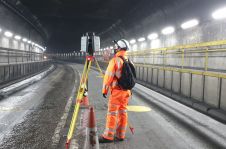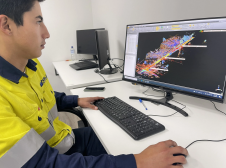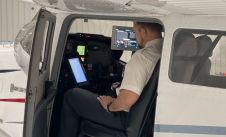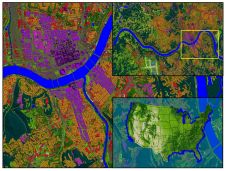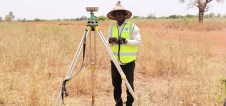More Maps From Big Data?
The rise of mapmaking amongst those without cartographic qualifications presents a challenge, argues Nico Regnauld. Big data and the ever expanding demand for mapping on a variety of devices means generalisation of datasets and integration of skills. The arrival of new software tools can speed up this work for both neo and traditional cartographers.
For centuries maps have been an effective way to display location information; how things relate to one another geographically. This information can be represented in many forms: georeferenced coordinates, addresses, place names, relative position (5 miles south of the Angel of the North) etc. The most useful maps, however, are those which combine several types of information, so that the reader can quickly spot correlations.
在数字时代,这种能力结合datasets which makes a map a powerful information and decisionmaking tool; be it planning teams working out how to widen a road through a valley, environmental departments planning flood defences or simply getting from A to B in the car. However, there are technical challenges to creating these new maps.
As data becomes more readily available and more voluminous, it becomes big data, and the technology needs to keep pace. The potential for maps is enormous – as big as big data! Perhaps we can now have all the maps and combinations of data we need. Or are there still some limitations to what can be done with the data and software available today?
Making Maps Today
Traditionally mapmaking has involved specialists professional cartographers skilled in the art of representing the world around us. These cartographers usually make maps for an organisation specialised in a particular domain; perhaps topography, roads, charts for navigation at sea or in the air, etc. The organisations usually capture and maintain large amounts of data at the highest level of detail they need, and then derive multiple map products from it.
Some of these are made available for general use and are widely distributed. For example, topographic maps which are used for outdoor leisure can also be used for a wide range of analytical tasks. Others target a very specific usage, like flying an aeroplane to the right destination or presenting geology.
We are now, however, seeing another kind of mapmaker, often referred to as the neo-cartographer, with little, if any, expertise in cartography. The rise of available data and the ease of access to it enables them to make a map, often just for personal use, using the information they need when they need it. It’s still not easy, as it requires tracking down the datasets, often from multiple sources, integrating them, and styling them before publishing a map. General purpose GIS software, such as the open source QGIS, will help them, but anything more complicated than overlaying layers on top of each other and styling them is non trivial.
New Challenges for Map Makers
If professional mapmakers have the experience to make easy to understand maps, they are now facing a new challenge: how to make more of them, more quickly and at lower cost.
The process of generalising data, so that the information can be displayed and understood at larger scale (more detailed) and smaller scales (to facilitate, for example, zooming in and out of a map on your phone), is still expensive and involves manual processes. Consumer demand for location based information has also created demand for more maps, more information on existing ones and maps for specific uses. So speeding up the mapmaking process is important for national mapping and cadastre agencies (NMCAs), which cover large territories. Automated generalisation can help these organisations increase their responsiveness to market needs, but creating niche maps will rarely be sustainable.
From the neo-cartographer’s point of view, speed is not so important. The challenge is to find the datasets, integrate them, and style them. The most complex and difficult stage is integration.
Fortunately, the NMCAs are developing ways to make their data available to users through geoportals. This will enable neo-cartographers to make their own maps using trusted and reliable datasets. These can be delivered as a set of base maps at several scales, often in raster format and sometimes also in vector. So the mapping industry is moving to provide neo-cartographers with better background data to make their maps and reduce the challenges all round. What about the tools?
Data Integration and Generalisation
To effectively integrate datasets and carry out some generalisation processes, neo-cartographers often still need programming skills and time, even though some software is available to help. They cannot access the automatic generalisation systems created by the NMCAs.
1Spatial has recognised the need to combine these approaches and bring more of the expertise of cartographers into the software. This will speed up the work of traditional cartographers, reducing costs and improving update rates. For the neo-cartographer, the software will mean easier integration and generalisation processes; and a wider range of possible maps.
1Integrate has been designed to help the user clean datasets from multiple sources and integrate them. It uses a rule editor that gives users the flexibility to create rules to detect correspondences between features from multiple sources and perform actions to integrate them as needed. This leads on to 1Generalise, designed to provide a ready to use, potentially on demand, generalisation service to both NMCAs and neo-cartographers.
The generalisation issue is not a new one, but these new technologies could have a significant impact on the work of both traditional and ‘neo’ cartographers. The more automated generalisation processes can be used to re-engineer legacy data for internal use, or to publish data products to customers. Either way, the automation will save huge amounts of manual effort and make previously impossible tasks possible – for both sides of the mapmaking community.
This article was published in GIS Professional June 2015
Make your inbox more interesting.Add some geo.
Keep abreast of news, developments and technological advancement in the geomatics industry.
Sign up for free



